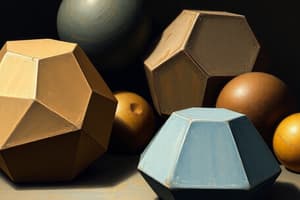Podcast
Questions and Answers
What is the definition of volume?
What is the definition of volume?
- A quantitative measure of the three-dimensional space an object occupies. (correct)
- A quantitative measure of the two-dimensional area an object covers.
- A measure of the weight of an object.
- A measure of the density of a material.
Which of the following is not a common unit of measurement for volume?
Which of the following is not a common unit of measurement for volume?
- Liters (L)
- Cubic meters (m³)
- Kilograms (kg) (correct)
- Cubic inches (in³)
Which formula correctly calculates the volume of a rectangular prism?
Which formula correctly calculates the volume of a rectangular prism?
- V = 4/3πr²
- V = a²h
- V = l × w
- V = l × w × h (correct)
For an irregularly shaped object, which technique is likely used to determine its volume?
For an irregularly shaped object, which technique is likely used to determine its volume?
Why is understanding volume essential in fields such as engineering and construction?
Why is understanding volume essential in fields such as engineering and construction?
Flashcards are hidden until you start studying
Study Notes
Definition of Volume
- Volume: A quantitative measure of the three-dimensional space an object occupies.
Key Concepts
-
Units of Measurement:
- Common units: cubic meters (m³), liters (L), cubic centimeters (cm³), gallons.
- One cubic meter is equivalent to 1,000 liters.
-
Volume Calculation:
- Depends on the shape of the object.
- Basic formulas for common geometric shapes:
- Cube: V = a³ (where 'a' is the length of a side)
- Rectangular Prism: V = l × w × h (length × width × height)
- Cylinder: V = πr²h (where 'r' is the radius, 'h' is the height)
- Sphere: V = (4/3)πr³ (where 'r' is the radius)
- Cone: V = (1/3)πr²h
-
Measurement Techniques:
- For irregular shapes, volume can be determined using water displacement methods.
- Use graduated cylinders or measuring containers for liquids.
-
Applications:
- Used in various fields including science, engineering, cooking, and construction.
- Essential for understanding capacity and material requirements.
Importance of Volume
- Volume is crucial for:
- Calculating capacity of containers.
- Determining the amount of material needed for manufacturing.
- Understanding physical properties of substances in chemistry and physics.
Definition of Volume
- Volume measures the three-dimensional space occupied by an object.
Key Concepts
-
Units of Measurement:
- Common units include cubic meters (m³), liters (L), cubic centimeters (cm³), and gallons.
- 1 cubic meter equals 1,000 liters.
-
Volume Calculation:
- Volume calculations vary based on the object's shape.
- Basic formulas for geometric shapes include:
- Cube: ( V = a^3 ) (where 'a' is the side length)
- Rectangular Prism: ( V = l \times w \times h ) (length × width × height)
- Cylinder: ( V = \pi r^2 h ) (where 'r' is the radius and 'h' is the height)
- Sphere: ( V = \frac{4}{3}\pi r^3 ) (where 'r' is the radius)
- Cone: ( V = \frac{1}{3}\pi r^2 h )
-
Measurement Techniques:
- For irregularly shaped objects, volume can be measured via water displacement.
- Use graduated cylinders or measuring containers to accurately determine liquid volumes.
-
Applications:
- Volume plays a significant role in science, engineering, cooking, and construction.
- Understanding volume is essential for capacity planning and material assessment in various projects.
Importance of Volume
- Critical for calculating the capacity of containers.
- Necessary for determining material requirements in manufacturing.
- Key to understanding the physical properties of substances in fields such as chemistry and physics.
Studying That Suits You
Use AI to generate personalized quizzes and flashcards to suit your learning preferences.




